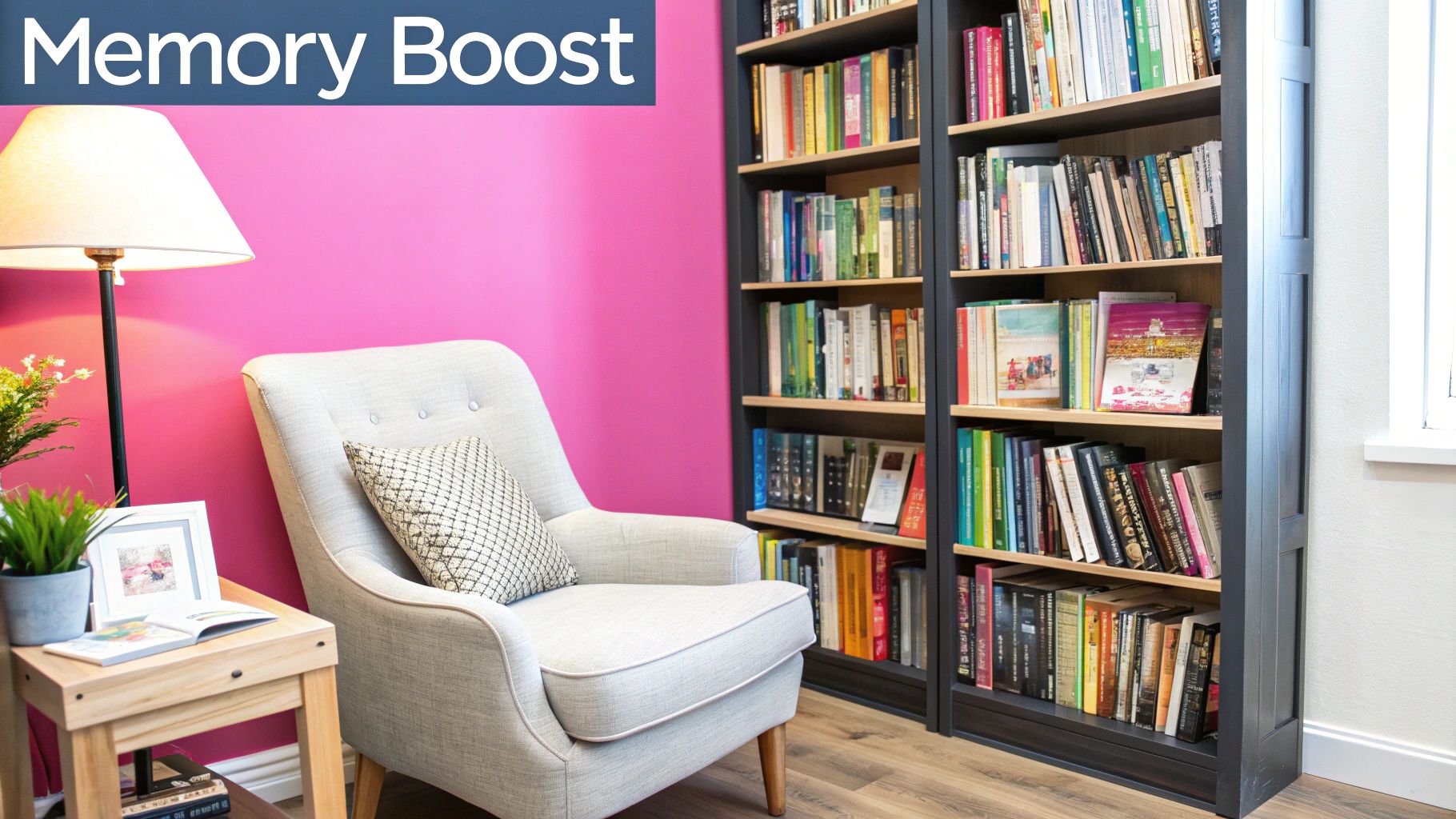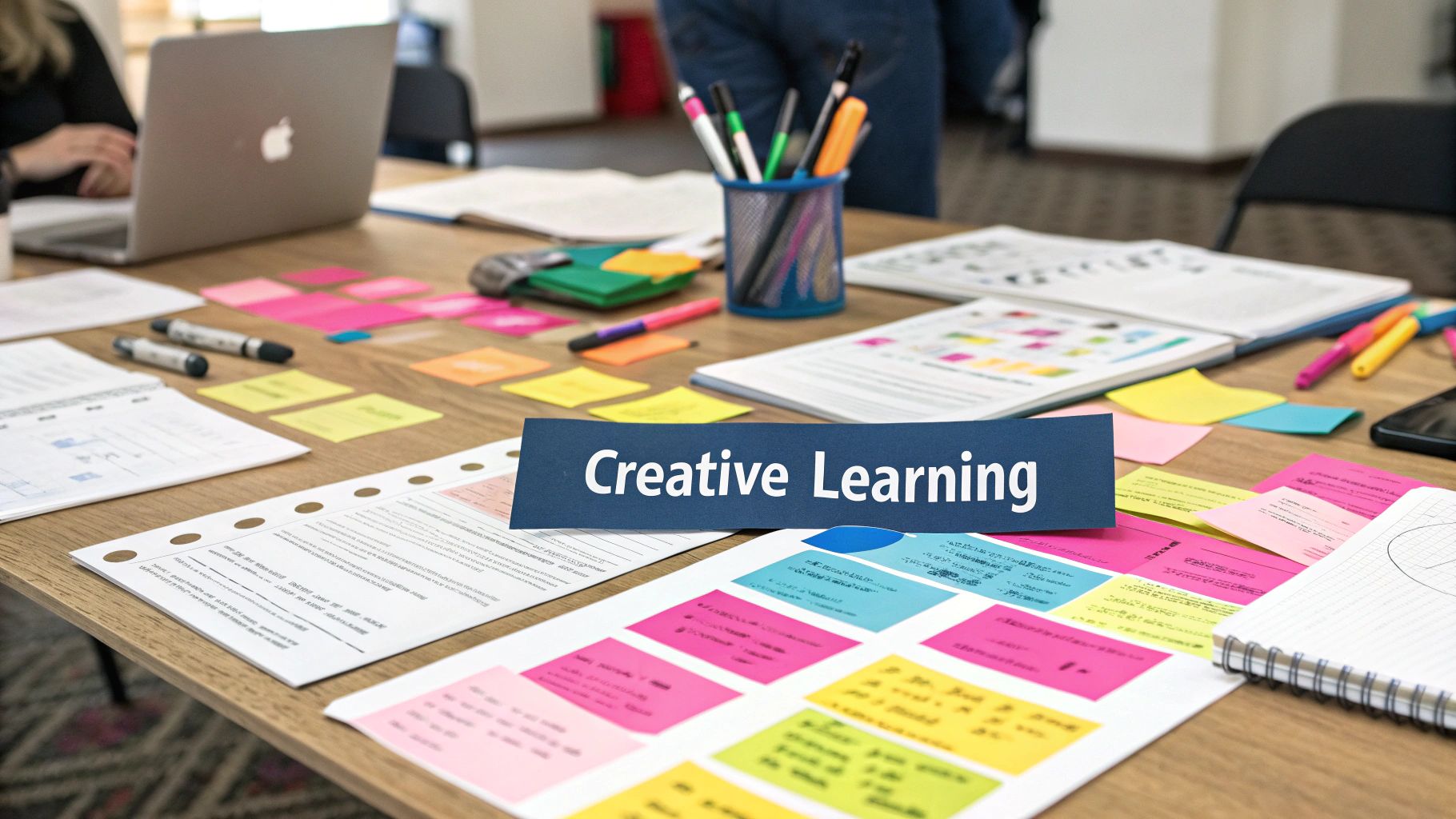
How to Improve Memory for Studying: Expert Strategies That Transform Learning Potential
Breaking Down the Science Behind Effective Learning

Understanding how the brain learns and retains information is key to developing better study habits. Our brains form and strengthen neural connections during learning, rather than simply absorbing information passively. This explains why basic memorization techniques often fail – they don't engage the multiple cognitive processes needed to create lasting memories. Research shows that involving different parts of the brain through active learning leads to much stronger retention.
The Power of Active Engagement
Active recall is one of the most effective ways to improve memory when studying. When you force your brain to retrieve information, you strengthen the neural pathways connected to that knowledge. Think of it like building muscle – just looking at weights won't make you stronger. Similarly, passively rereading notes doesn't challenge your brain enough. You need to test yourself and actively pull information from memory. Each time you do this mental "workout," those neural connections get stronger, making future recall easier.
Spaced Repetition: Optimizing Your Study Intervals
Spaced repetition takes advantage of how our brains naturally process and store information over time. Rather than cramming everything into one session, reviewing material at gradually increasing intervals leads to much better long-term retention. For instance, going over notes after one hour, then one day, then one week helps move information from short-term to long-term memory. This method directly counters our natural tendency to forget and ensures the knowledge sticks.
Mnemonics: Building Memory Bridges
Mnemonics provide another valuable tool for improving study memory. These memory techniques create vivid mental connections that make abstract information more concrete and memorable. They act as mental shortcuts by linking new concepts to knowledge you already have, creating easy-to-remember "hooks" for later recall. Whether it's a simple acronym or a detailed mental image, mnemonics transform hard-to-grasp ideas into something your brain can easily access.
Chunking: Managing Information Overload
Chunking helps overcome the natural limits of short-term memory by organizing information into manageable groups. Rather than trying to remember many separate pieces of information, we can package related items together. For example, breaking down a long number sequence into smaller chunks makes it much easier to remember. This approach helps prevent mental overload and makes both learning and recall more efficient. By understanding and applying these core principles of how memory works, we can move beyond ineffective passive studying to methods that create lasting knowledge.
Spaced Repetition: A Proven Method For Long-Term Learning

Building on what we know about active recall and memory techniques, spaced repetition offers a systematic approach to retaining information over time. Instead of cramming material all at once, this method spaces out study sessions strategically to help move information from short-term to long-term memory. The results speak for themselves – students who use spaced repetition consistently show better retention and deeper understanding of their study materials.
Understanding the Spacing Effect
Research in cognitive psychology has repeatedly shown that spreading out study sessions leads to better learning than concentrated cramming. For instance, reviewing material after progressively longer intervals – first after an hour, then a day, then a week – creates stronger memories than reviewing the same content multiple times in one sitting. This works because each review session forces your brain to actively recall the information, which strengthens the neural connections storing that knowledge.
Implementing Spaced Repetition in Your Studies
Getting started with spaced repetition is straightforward. Begin with frequent reviews shortly after first learning the material, then gradually increase the time between review sessions as your recall improves. Your review schedule might start with same-day reviews, then extend to next-day reviews, followed by weekly and monthly reviews. This approach aligns with how our brains naturally process and store information for the long term.
Practical Strategies and Tools for Spaced Repetition
You have several options for putting spaced repetition into practice:
- Flashcards: Traditional paper flashcards work well when organized into different piles based on how well you know the material and when you need to review it next.
- Spaced Repetition Software (SRS): Apps like Anki or Notescast handle the scheduling automatically. Notescast adds an extra dimension by converting your study materials into video content, making reviews more engaging. These tools track your progress and adjust review timing based on how well you recall each item.
- Study Schedule: Map out your review sessions using a calendar or planner, marking specific dates and times for reviewing different topics.
Overcoming Common Challenges
While spaced repetition is highly effective, it does require commitment and planning. Skipping scheduled reviews can disrupt the learning process, and setting up a review system takes more initial effort than last-minute cramming. However, the payoff in better understanding and longer retention makes this investment worthwhile. Different subjects may need different review intervals – complex topics might require more frequent initial reviews before spacing them out. By staying consistent and adjusting your approach based on results, you can make spaced repetition a powerful tool for building lasting knowledge.
Mastering Active Recall: Beyond Passive Reading
Along with spaced repetition, active recall is essential for building strong study habits. While spaced repetition determines when to review material, active recall shapes how you engage with it. Instead of just reading notes or textbooks over and over, active recall pushes you to pull information from your memory – making study sessions far more effective.
Why Active Recall Works
Much like physical exercise strengthens muscles, active recall builds mental connections. Simply reading information is like watching someone else work out – it won't make you stronger. Each time you actively retrieve knowledge from memory, you reinforce those neural pathways, making future recall easier. Research clearly shows the benefits: students who test themselves regularly remember significantly more than those who just reread their notes.
Putting Active Recall Into Practice
You can use active recall in many ways to improve your study routine. Here are some proven techniques to try:
- The Testing Effect: Challenge yourself with practice tests and quizzes, either using flashcards or online platforms. Testing forces you to recall information rather than just recognize it.
- The Feynman Technique: Try explaining complex topics as if teaching someone else. This reveals gaps in your understanding and helps solidify key concepts.
- Self-Explanation: As you study, pause regularly to explain the material to yourself in your own words. This helps process information more deeply.
- Free Recall: After studying a section, write down everything you remember without looking back. This helps identify weak spots in your knowledge.
Tailoring Active Recall to Different Subjects
Active recall works well across all subjects – you just need to adjust your approach:
| Subject | Active Recall Technique |
|---|---|
| History | Create timelines and explain the significance of key events. |
| Math | Work through practice problems without referring to the solutions. |
| Languages | Practice speaking and writing in the target language. |
| Science | Diagram complex processes and explain them in your own words. |
While active recall requires more effort than passive reading, the results are worth it. By actively engaging with the material, you'll build stronger memories and deeper understanding that serves you well in exams and real-world applications. When combined with spaced repetition, active recall becomes an even more powerful tool for mastering any subject.
Building Your Personal Memory Palace

When it comes to mastering large amounts of information, the memory palace technique offers a proven solution. This ancient method, first used by Greek and Roman orators to remember lengthy speeches, helps organize information using familiar locations as memory anchors. By converting abstract concepts into vivid mental images, you can significantly improve your ability to retain and recall information while studying.
Choosing the Right Foundation: Your Palace
Start by selecting a place you know extremely well – it could be your current home, the house you grew up in, your daily commute route, or even a favorite game environment. The key is picking somewhere you can picture clearly in your mind, with distinct features you can easily visualize. For example, if you choose your home, specific spots like the entryway, kitchen counter, or bedroom window can serve as memory stations. The more familiar you are with the location, the more effectively it will work as your memory foundation.
Furnishing Your Palace: Creating Vivid Associations
After selecting your palace location, begin linking the information you need to remember with specific spots in that space. The more unusual and striking these mental connections are, the better you'll remember them. For instance, if you're studying biology's Krebs cycle, imagine each step happening in different rooms – picture acetyl-CoA bursting through your front door in a dramatic entrance, citrate doing a dance routine on your kitchen table, and isocitrate floating in your bathtub. These memorable mental scenes make abstract concepts much easier to recall later.
A Walk Through the Palace: Retrieving the Information
When you need to recall the information, simply take a mental stroll through your palace. As you visit each location, the associated images and details will come back naturally. This method works with your brain's spatial memory abilities, making it much more effective than trying to memorize abstract facts in isolation. By connecting information to specific places, you create an organized system for retrieval – like following a familiar path to find what you need. Research on memory champions shows that this method enables remarkable feats of recall.
Expanding and Adapting Your Memory Palace
As you get comfortable using your memory palace, you can grow it by adding new areas, creating additional routes, or building separate palaces for different subjects. The technique works for many types of information – from historical dates to chemical equations. A language student might picture vocabulary words throughout their palace, like seeing a "chat" (French for cat) lounging on a bookshelf or a "livre" (book) open on their desk. If certain associations aren't sticking, simply replace them with more memorable ones. With consistent practice and refinement, you'll develop a powerful, personalized system for mastering any subject through improved memory techniques.
Crafting Powerful Memory Hooks Through Mnemonics

Mnemonics help us remember information more easily by converting complex facts into simple, memorable patterns. Rather than relying on pure repetition, these techniques tap into our brain's natural ability to make connections and recognize patterns. This makes learning feel more intuitive and helps information stick in our minds for the long term.
Exploring Different Types of Mnemonics
There are several effective mnemonic approaches that work for different learning styles and subjects. One common technique is using acronyms – taking the first letter of each word to create a memorable abbreviation. For example, music students use "Every Good Boy Deserves Fudge" to remember the lines of the treble clef (E, G, B, D, F). Similarly, ROYGBIV helps us recall the colors of the rainbow in order. These simple memory triggers make it much easier to remember lists and sequences.
Visual learners often find success with image-based memory techniques. This involves creating clear mental pictures that connect to what you're trying to learn. For instance, to remember H2O (the chemical formula for water), you might picture two hikers (representing H2) walking toward an oasis (representing O). The more unusual or striking the mental image, the better it sticks in your memory. This approach gives abstract concepts a concrete form that's easier to recall.
Chunking: Organizing Information For Optimal Recall
Chunking works hand-in-hand with mnemonics by breaking down information into manageable groups. This method plays to the strengths of our short-term memory, which handles smaller chunks much better than long strings of data. For example, we naturally chunk phone numbers into groups like (555) 123-4567 instead of trying to remember all 10 digits in sequence. This simple organization makes the number much easier to remember.
When studying complex topics, chunking helps break down overwhelming amounts of information. Take the Krebs cycle in biology – instead of memorizing each chemical change separately, students can group related steps together into meaningful chunks. This creates a clearer mental map of the process and makes the information easier to recall during exams.
Crafting Customized Mnemonics That Work For You
The best mnemonics are the ones you create yourself because they connect to your personal experiences and way of thinking. Some people learn best through rhymes, while others prefer visual associations or physical movements. A history student might make up a catchy rhyme about important dates, while someone learning a new language could use songs to remember vocabulary. The key is finding what resonates with your learning style.
Building bridges between new concepts and things you already know also strengthens memory. For example, when studying physics concepts like gravity, think about everyday experiences like dropping objects or watching leaves fall. These real-world connections make abstract ideas more concrete and memorable. By actively creating these personal memory hooks, you turn passive studying into engaging learning that sticks with you long-term. The more you practice creating your own mnemonics, the better you'll become at quickly remembering new information.
Creating Your Customized Memory Enhancement System
After exploring key techniques like spaced repetition, active recall, memory palaces, and mnemonics, it's time to combine these methods into a personalized system that works best for you. Building an effective study approach requires thoughtfully selecting and integrating the right tools for your learning style and goals.
Designing Your Personalized Study Toolkit
Not every memory technique works equally well for all subjects and learning styles. The key is identifying which methods complement your natural tendencies and match your study material. For instance, if you learn best through visualization and struggle with historical timelines, try creating a memory palace where you place key figures and events in familiar locations. This transforms abstract dates into vivid mental scenes you can easily recall.
For subjects like physics that involve complex concepts, the Feynman Technique of explaining ideas in simple terms often works better. When you try teaching a concept to someone else, it quickly reveals any gaps in your understanding that need more work.
Structuring Your Study Sessions for Optimal Retention
A consistent study schedule helps you implement these techniques effectively. Consider dedicating specific time blocks to different subjects and methods – perhaps Monday mornings for flashcard review using spaced repetition and Wednesday evenings for building memory palaces. This structured approach prevents overwhelm and builds sustainable study habits.
Your study environment matters too. Some students focus best in quiet libraries, while others prefer ambient coffee shop noise. Test different settings to find what helps you concentrate and retain information most effectively.
Tracking Progress and Adapting Your Approach
Regular progress monitoring helps optimize your memory system over time. After each study session, reflect briefly on what worked well and what needs adjustment. Are certain images in your memory palace hard to recall? Try making them more distinctive and memorable. Do you consistently miss certain types of practice questions? This signals areas needing extra review and reinforcement.
Think of this as an ongoing feedback cycle – assess your results, identify weak spots, adjust your methods accordingly. For example, if your current spaced repetition intervals feel too easy, gradually increase the time between reviews to challenge yourself more.
Troubleshooting Common Challenges
Even well-designed study systems face obstacles. Consistency is often the biggest challenge – when life gets busy, scheduled study sessions can slip. Combat this by integrating study blocks into your regular calendar and setting reminders. Breaking large topics into smaller segments also makes studying feel more approachable and helps maintain momentum.
Like any skill, improving your memory takes dedicated practice over time. But by implementing these strategies thoughtfully and refining them based on results, you can significantly boost your learning capacity.
Ready to take your studying to the next level? Notescast helps transform your notes into engaging videos and provides built-in spaced repetition tools to optimize retention. Visit https://notescast.app/ today to experience more effective studying.
